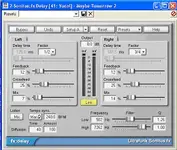P
Pykon
New member
Hi @ll!
My question is: which effects (apart from compressor/gate, eq) you use for vocals in the mix?
I'm used to adding some reverb to de-center the vocal line in the mix, but how to achieve the goal when I need more intimate - so non-reverbed - sound?
Please name the particular effects/plug-ins.
I'm a sonar-man, in 7 pro I have some smart effects library, so show me the way to experiment.
mike
My question is: which effects (apart from compressor/gate, eq) you use for vocals in the mix?
I'm used to adding some reverb to de-center the vocal line in the mix, but how to achieve the goal when I need more intimate - so non-reverbed - sound?
Please name the particular effects/plug-ins.
I'm a sonar-man, in 7 pro I have some smart effects library, so show me the way to experiment.
mike





